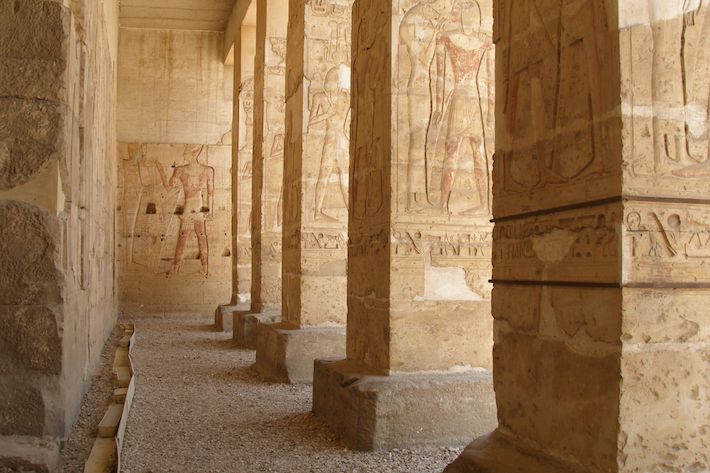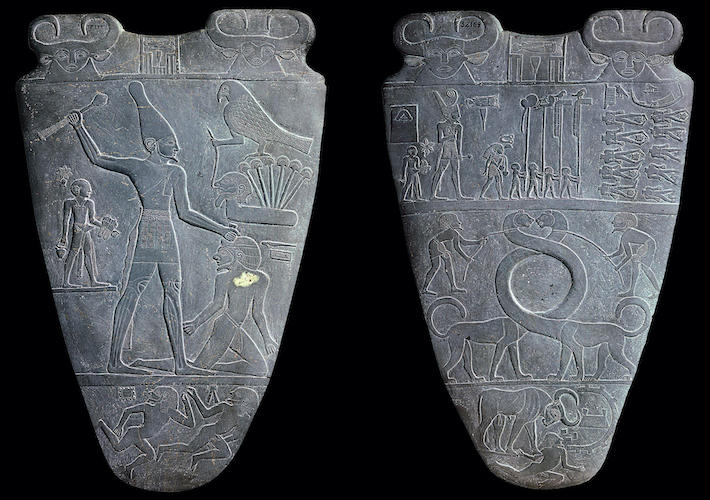 The ancient Egyptian city of Tjenu, or Thinis, as it was later known to the Greeks, is as enigmatic as the many gods of Egypt’s pantheon. Although its existence is attested by ancient writers, the city’s location remains unknown. The early third-century B.C. Egyptian historian Manetho wrote of Thinis as the ancestral home of Egypt’s first rulers. These rulers, however, were interred at the sacred site of Abydos. For more than three millenia, the temples at Abydos—one of Egypt’s oldest cities and the cult center of Osiris, god of the underworld and afterlife—hosted festivals dedicated to Egyptian gods and kingship. “There’s literature characterizing the early kings, who were buried in the royal cemetery at Abydos, as Thinite, or part of the Thinite Dynasty,” says archaeologist Matthew Adams of New York University. “But there are times throughout the Pharaonic period (ca. 3100–332 B.C.) when Thinis is referring, in a general sense, to the broader region, including Abydos, rather than the ancient city of Thinis itself.” Abydos’ Umm el-Qa’ab cemetery held the tombs of 1st Dynasty rulers, including King Narmer and Queen Merneith, and the 2nd Dynasty kings Peribsen and Khasekhemwy. Most of these rulers probably hailed from Abydos, which was likely Egypt’s capital, not Thinis, as Manetho implies.
The ancient Egyptian city of Tjenu, or Thinis, as it was later known to the Greeks, is as enigmatic as the many gods of Egypt’s pantheon. Although its existence is attested by ancient writers, the city’s location remains unknown. The early third-century B.C. Egyptian historian Manetho wrote of Thinis as the ancestral home of Egypt’s first rulers. These rulers, however, were interred at the sacred site of Abydos. For more than three millenia, the temples at Abydos—one of Egypt’s oldest cities and the cult center of Osiris, god of the underworld and afterlife—hosted festivals dedicated to Egyptian gods and kingship. “There’s literature characterizing the early kings, who were buried in the royal cemetery at Abydos, as Thinite, or part of the Thinite Dynasty,” says archaeologist Matthew Adams of New York University. “But there are times throughout the Pharaonic period (ca. 3100–332 B.C.) when Thinis is referring, in a general sense, to the broader region, including Abydos, rather than the ancient city of Thinis itself.” Abydos’ Umm el-Qa’ab cemetery held the tombs of 1st Dynasty rulers, including King Narmer and Queen Merneith, and the 2nd Dynasty kings Peribsen and Khasekhemwy. Most of these rulers probably hailed from Abydos, which was likely Egypt’s capital, not Thinis, as Manetho implies.
 Whether home to Egypt’s first pharaohs or not, Thinis became an influential political center of the 8th nome, or province, in Upper Egypt. “From the Old Kingdom (ca. 2649–2150 B.C.) on, Thinis was a provincial capital,” says Adams. “It had a mayor, overseers of priests, and extensive cemeteries that developed across the Nile.” Early Dynastic (ca. 3100–2649 B.C.) and Old Kingdom texts attest to the existence of a census, taxes, and irrigation systems. “Thinis seems to be this province’s primary administrative center for most of Pharaonic history,” says Adams.
Whether home to Egypt’s first pharaohs or not, Thinis became an influential political center of the 8th nome, or province, in Upper Egypt. “From the Old Kingdom (ca. 2649–2150 B.C.) on, Thinis was a provincial capital,” says Adams. “It had a mayor, overseers of priests, and extensive cemeteries that developed across the Nile.” Early Dynastic (ca. 3100–2649 B.C.) and Old Kingdom texts attest to the existence of a census, taxes, and irrigation systems. “Thinis seems to be this province’s primary administrative center for most of Pharaonic history,” says Adams.
Egyptologists know that Thinis’ sprawling cemeteries at the site of Naga ed-Deir on the Nile’s east bank lie across the river from the modern city of Girga—under which the remnants of Thinis may be buried. “The general location of Thinis can be identified because of these cemeteries,” Adams says. “But where, exactly, is the ancient archaeological site? It’s an open question.” A century ago, archaeological ruins were visible around the edges of Girga, but they were either obliterated or built over, and, explains Adams, can no longer be seen. “Nobody has gone looking or done archaeological reconnaissance or testing to find them,” he says. As with many ancient provincial towns in the Nile Valley, which have seen thousands of annual floods, Thinis’ remnants likely remain obscured under layers of alluvium that have been deposited over the millenia. For now, it seems that the once-great city, a potential key to understanding the rise of Egyptian civilization, has been lost to the desert from which it came. “It would be an extremely interesting site to investigate,” says Adams. “I would certainly urge somebody to give it a try.”